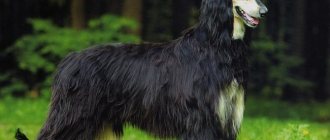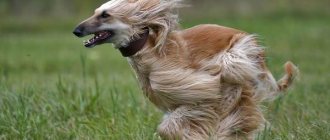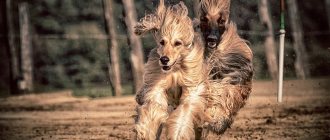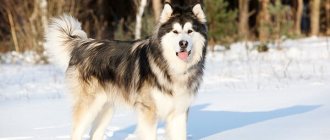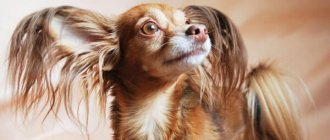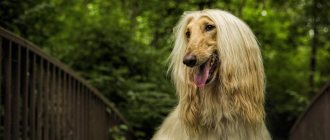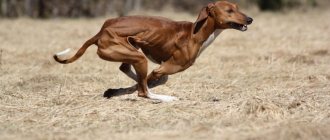Home » Dog Breeds
Classification Origin : Afghanistan
FCI classification : group 10 - greyhounds; section 1 - long-haired greyhounds
Use: hunting dog
Color: black, white, black and white, beige, red, blue, silver
Dimensions: Males - 68-74 cm, females - 63-69 cm, body weight - 20-30 kg
Lifespan: 10-12 years
The Afghan Hound is one of the most ancient hunting dog breeds. These are very brave and devoted pets with a stately and proud appearance.
The dog's ancestors differed in many ways from today's Afghan hound: they were more aggressive and did not have such attractive appearance.
This dog breed also has other names: Afghan, Bakhmul, Afghan Italian Greyhound.
In Afghanistan, the Afghan hound is called Tazi, which means “fast running”.
- 2 Application
- 3 Description
- 4 Psychology
- 5 How to choose a puppy
- 6 Features of care
- 7 Combing
- 8 Bathing
- 9 Walk
- 10 Food
- 11 Health
- 12 Characteristic diseases
- 13 Vaccinations
- 14 Mating
History of the breed
Images of Afghans dating back to the 2nd century BC were discovered in Afghanistan. The archaeological find was one of the good reasons why the breed received its current name.
Until the end of the 19th century, the Afghan hound was distributed only in Afghanistan. The removal of dogs from the state was prohibited.
This is the only breed of the Italian Greyhound that is revered in a Muslim country.
The animal was brought to Europe by the British military, who served on the border of the Afghan and Indian states. At the beginning of the 20th century, the first club for lovers of this breed appeared in London.
Then the Afghan gained popularity in America.
The Afghan Hound was able to receive recognition from the World Canine Association
Mating
The third heat is considered optimal for mating. The process occurs over a period of 1.5 to 2 years . Males are bred up to 4 years old , bitches - up to 2 years old . The standard period is from 10 to 12 noon . The bitch must be completely ready for fertilization. The dogs are introduced in advance. It is important to take time for pre-courtship.
Application
Since ancient times, hunters have used dogs to catch wild animals, both large and small.
The Afghan Hound is one of the most resilient and fastest dogs, capable of reaching speeds of up to 50 km/h.
If you are interested in learning about the fastest dog in the world, we recommend reading the article
Like the Russian or Estonian hounds, when they overtake the victim, the Afghan holds the prey until the owner arrives.
The dog was also used as a guard for livestock and houses. Now this breed of dog actively takes part in exhibitions and is simply a pet for lovers of this breed.
In photos and in life, Afghans look like real aristocrats
Key points in training
Training Afghan Hounds requires patience and skill. The result will not be noticeable immediately. However, it is strictly not recommended to give up training. At the first stage, you should master simple orders. It is necessary to develop a motivation system that is interesting for the dog. Initial attempts should be made immediately after the puppy appears in the house. He can be stubborn and show character. Before the age of 12 weeks, contact with the owner is established, so sufficient communication is necessary. You can teach your puppy the following commands on your own:
- "To me"
- "Place"
- “Sit and lie down”
- “Give me your paw!”
These manipulations are considered basic, therefore they are part of almost all first training sessions. The character of the dog should be taken into account. She should not be scolded or ignored. Encouragement and communication play an important role here . The owner must demonstrate respect and love. Only in this case the desired result is achieved. Afghan hound training is best done under the direct supervision of a professional in this matter.
The process requires maximum effort only on the part of a person. Additionally, you will need to come up with a learning algorithm individually. It depends on temperament and contact with the owner.
Read about how to properly train a dog in the article: “Training a puppy: effective methods from dog handlers, learning commands at home.”
Description
The Afghan Hound is a dog with a strong body and well-developed muscles. The skull of this breed has an elongated shape with an occipital protuberance.
Scissor jaws have a straight bite. The eyes are slightly slanted, dark in color, almond-shaped.
The low-set, drooping ears lie close to the head. The animal's strong, robust neck is elongated. The tail is of medium length and has a tail ring.
Long, strong legs covered with long hair. The body also has long, thick and straight hair. The Afghan breed is physiologically similar to the Russian greyhound .
The movements of the African greyhound when running are smooth and free.
Afghan hound puppies up to one year old have thick, soft and long hair on their cheekbones.
As for color, different shades of colors are acceptable. The following color options are available:
- black;
- white;
- pale yellow;
- silver;
- beige;
- black and white;
- brindle;
- blue.
If you are interested in looking at unusual dog colors, we recommend the following article:
Blue Afghan Hound
Red Afghan Hound
Beige Afghan Hound
White Afghan Hound
Health
All dogs can suffer from genetic diseases, just like humans. Run away from a breeder who does not guarantee the health of the puppies, but says that the breed is 100% healthy and there can be no problems with it.
A reputable breeder will be honest and open about health problems in the breed, and especially in his line. This is normal, since all dogs get sick from time to time, and anything can happen.
The most common diseases in Afghan Hounds are: dysplasia, cataracts, thyroiditis (an autoimmune disease that destroys the thyroid gland), laryngeal paralysis in dogs, and von Willebrand's disease (a blood disorder).
At a minimum, ask the seller if the manufacturers suffer from cataracts and if there are any problems with the joints. Better yet, demand proof.
In a good kennel, dogs undergo genetic tests, as a result of which animals with hereditary diseases are eliminated, and only the healthiest remain. But nature has its own secrets and despite this, mistakes happen and sick puppies appear.
Remember that as soon as you bring your puppy home, the most likely disease he will face is obesity. Maintaining a constant, moderate weight is one of the simplest and most effective ways to prolong your dog's life. Considering that this is a hunting dog, it is obvious that the basis of its health is walking and running.
Ideally, to stay in shape, she needs up to two hours of walking a day, but which city dweller can afford this? Moreover, a nuance arises: these dogs can get carried away by chasing a cat or just running and completely forget about the owner.
And, if in nature this is not so scary, then in the city it is a problem. It is advisable not to let go of the leash if you are not sure of her obedience and do not want to run after her for a long time.
Plus, walking in the summer is difficult for her, since her long coat is designed to retain heat in the mountain climate, and not in the hot desert of the microdistrict.
As a result, the best physical activity for this dog is walks in nature, in remote corners of parks and plantings, and sports disciplines such as coursing.
You definitely need to walk this dog a lot, otherwise the muscles will atrophy. Somewhere in nature you can give it free rein! How happy she is about this! Any hare would envy such jumping ability, agility, and flight in the air while jumping!
Psychology
A dog of this breed is not characterized by dominance, but sometimes the Afghan can be stubborn. The Afghan Hound has a calm temperament and usually does not show strong emotions.
Read about other stubborn dog breeds here:
Despite this, the dog needs constant communication and attention from its owner, to whom it is capable of showing immense affection.
Afghan Hound puppies are very active and affectionate with all family members. As they grow up, pets begin to show more and more independence.
This animal is not characterized by aggression, but the instinct to protect its own territory is well developed. An Afghan treats strangers who come into the house with caution.
It is not recommended to have these pets where a child is expected. The Afghan Hound can be very shy and cannot tolerate loud noises.
She will not make a good companion dog as she may be careless around children.
Important! The Afghan is difficult to train even in the hands of an experienced dog handler.
Before getting a dog of this breed, you need to think carefully. The animal belongs to the category of the most difficult to train. Even an experienced trainer is not always able to teach a dog all the necessary skills.
Afghan hound puppies
Training and education
They are poorly trained due to their character. Stubbornness, independence, disobedience and independence make training very difficult. However, if you find an approach, be patient and be persistent, you can train your pet. It is recommended to contact specialists for this breed.
Submitting a dog doesn't always work. The principle of complete submission of the Afghan hound to the owner is an outdated method. This theory was formulated based on observations of packs of wild wolves, but they were kept in captivity and, of course, experienced stress. The stress condition forced wolves to show aggression towards each other, but in the wild they do not show aggression to each other - they live together and interact with each other. You need to perceive yourself as the more experienced and mature member of the pack, who is responsible for guiding the new member (Afghan Hound puppy) and teaching him good behavior, as well as correcting him if necessary. It is important to remember that Afghan Hound puppies learn a lot on their own. They are very inquisitive, love to explore new territories and, of course, experiment. Puppies tend to repeat actions they enjoy (like playing with a toy). They do not repeat actions that cause them pain (for example, destroying a nest and getting bitten). If your Afghan Hound puppy misbehaves, ignore him and praise him when he does the right thing. Reward your puppy for following commands and good behavior. Do not neglect these tips. After all, constantly hearing “you can’t” all day long is unbearable. This is a small child who wants to know everything and get his portion of treats as a reward for not eating your favorite rug, going to the toilet outside, bringing you a ball, and so on.
Set rules and monitor their implementation
It is worth enrolling your Afghan Hound puppy in obedience training classes. These classes will allow you to understand exactly what actions will allow you to control your dog’s behavior. You will be able to spend more time with your puppy, establish contact and socialize around other dogs.
Adviсe
- Training an Afghan hound puppy should be done with the help of positive motivation; watch carefully special films about this technique. The Canine Translator film series from National Geographic is suitable.
- If you need to leave your puppy at home alone for 2 hours or more, then ask someone to come to him.
- Be sure to schedule your Afghan Hound puppy's veterinarian appointment as soon as possible. The doctor will carefully examine him and give him vaccinations that will protect him from dangerous diseases.
How to choose a puppy
Afghan hound puppies are very different from adults, so it is extremely difficult to determine a healthy animal when choosing. The appearance of a young pet will say little about what kind of dog will grow up.
Afghan Hound puppies look awkward and have somewhat shabby fur.
You should only buy a young pet from nurseries with a good reputation. The price of a healthy pet with a pedigree cannot be low.
The dog must have a veterinary passport with the necessary vaccinations. Also pay attention to the animal's pedigree.
Before purchasing a small Afghan, you should observe its behavior for half an hour. Healthy puppies are always active and curious.
Afghan hound puppies develop extremely slowly, so it is not recommended to remove them from their bitch before three months of age.
Starting at this age, they become more independent and do not suffer separation from their mother so painfully. On the day of weaning, the little pet needs the care and attention of its new owner.
The price for this dog breed is 15 thousand rubles and more. An Afghan Hound intended for exhibition and breeding can cost much more. The average price for such puppies starts from 25 thousand rubles.
Professional nurseries not only provide a full package of documents for the animal, but also provide all the necessary information on proper care and maintenance.
Clients are often given a discount on specialized food , and some nurseries even assist in transporting the puppy to a new home.
Price
The price of an Afghan hound depends on many indicators. You can buy a pet second-hand, without documents, vaccinations and with a dubious pedigree, for 15,000-2,000 rubles. But a purebred Afghan, which was raised in a nursery, vaccinated, has all the documents, meets all the standards of its breed, and can boast of its famous parents, will cost much more. For such a puppy you will have to pay from 50,000 to 100,000 rubles. The color of the Afghan hound also influences the cost of your future furry friend. Dark individuals will cost a little more.
Features of care
This breed of dog is not suitable for keeping in an apartment. The animal needs a lot of space and regular exercise. If they are absent, the dog may get sick.
If the pet is kept in an apartment, then it needs daily walks, which in total should last at least three hours.
During the walking period, the Afghan should be allowed to run and, if possible, be occupied with active games, for example, agility .
Important! Be sure to inspect your animal's paws for wounds and cracks after walks. If present, the affected areas are wiped and lubricated with vegetable oil.
The dog not only needs active walks, but also requires special care. This applies to the ears, eyes, claws and fur of the animal.
You should regularly examine your pet's eyes and prevent souring. From time to time they are wiped with weak tea leaves using a cotton pad.
Ears, if dirty, are also treated with a damp cotton pad.
The Afghan's claws are trimmed once every four weeks with a special nail clipper for large breeds.
Up to two times a week, the dog undergoes oral hygiene using a specialized paste and brush. It is also necessary to use toys that help clean teeth.
Afghan Hound puppies should be taught the rules of hygiene from a very early age so that they do not resist any procedures in the future.
The Afghan needs to be socialized with other large breeds when walking.
Character
It is difficult to call such an animal simple and easy in terms of raising. He is quite smart, but is reluctant to make contact. For successful pair hunting, it needs a responsible and strong owner who will lead him and tell him what to do. Trust is the main character trait of the Afghan Hound.
This animal looks closely at a specific person for a long time, analyzing his actions and manner of communication. He does this in order to determine whether he can be trusted. The second character trait of the dog is stubbornness.
It is not easy to force him to obey, for example, to follow a command. There are a number of factors that negatively affect a dog’s mood: weather, food, toys, people, etc. If she is sad about something, then nothing in the world, not even the authority of the owner, will force her to obey.
Such dogs do not get along well with children. Babies' cries, laughter or any loud noises irritate them. If the animal is upset about something and the child violates its personal space, it may bite. He knows no shame.
Also, it should be noted that the proud hunter does not favor the owner’s other pets. He treats cats and some small vertebrate animals with disdain. Conflicts in a pack of dogs that includes a representative of this breed are inevitable.
Yes, these are wayward animals. Growing up, they can change their character several times. The mood of such dogs depends on a number of factors, the main one of which is the mood of the owner. If he is friendly, the animal will become obedient and pliable, but if not, he will become rude and distant.
Experts say that the psyche of the Afghan hound is unstable. The animal is difficult to socialize, prone to conflict behavior, and sometimes aggressive. However, such behavior and attitude often become his defensive reaction.
The dog is quite timid and cautious, but not when hunting. In a forest setting, she has no shortage of courage. That is why it is not recommended to purchase such a dog if there are rats, mice and squirrels in the house. When interacting with such animals, a bloodthirsty instinct may awaken in him.
He often treats members of the household kindly. Needs a kind and caring attitude. Moderately curious, fearful, cautious. He approaches strangers in the house only if they are friendly to him, smile and speak quietly.
Loud sounds (except a gunshot) cause fear in the Afghan, so he avoids the people who make them. But, regardless of the attitude towards a particular person, when interacting with him they always maintain a sense of self-esteem and arrogance.
Combing
This breed of dog requires careful daily grooming. In its absence, the dog’s appearance will immediately lose its attractiveness.
Important! Treat your pet monthly with a flea and tick preventative.
The Afghan must be combed with a special brush daily, after each walk. If this is not done, tangles will soon begin to form, giving the animal a sloppy appearance.
Before combing, it is recommended to spray the coat with water and conditioner for smooth-haired dogs.
For combing, purchase a brush with metal teeth. Start combing your pet from roots to ends. During shedding, you need to use a furminator for long-haired breeds.
Reproduction and lifespan
These wayward dogs live from 12 to 14 years. They require systematic care. A breeder of hunting dog breeds knows that they become sexually mature early. An Afghan Hound female can be bred with a male dog no earlier than 2 years after birth, although her first heat occurs at 8-9 months.
Once her period starts, it takes 4 days. During this period, acquaintance with the male should take place. Each of the candidates for mating must be of high breed. If the male and female do not get along, their meeting is postponed for a day. By the way, it happens only on his territory, and not on hers.
A pregnant Afghan bitch needs special treatment. During the 68-70 days of gestation, she should gain a little weight. She should walk less, no more than half an hour a day. If the dog is tired and does not want to get up, do not force it to do so.
Bathing
Dogs taking part in exhibitions are washed once a week. Other pets need less frequent bathing.
To carry out the procedure, use shampoo and conditioner for smooth-haired dogs. Wash the dog in a lying position.
After bathing, the pet's fur is dried with a towel and then styled with a hairdryer.
With proper care, your dog's coat will always be beautiful.
Walk
Due to the built-in hunting instinct, the Afghan hound can attack a cat or even a flying bird. Therefore, when walking in public places, the dog should be kept on a leash with a harness and, best of all, with a muzzle.
The ideal option would be to walk the animal outside the city, where the pet can run around and play enough.
Important! The dog of this breed is accustomed to a cool mountain climate. Physical activity and walking in hot weather are dangerous for an Afghan's health.
During walks, the Afghan needs to ensure communication with other large breeds. This has a good effect on the animal’s psyche and makes it more balanced.
Pros and cons of the breed
Only those who are willing to devote a lot of time to caring for, training, and walking their pet will benefit from the Afghan Hound breed. It will be difficult for beginners to cope with such a dog. In any case, before buying an Afghan puppy, you should familiarize yourself with the main pros and cons of the breed.
Advantages:
1. Exotic appearance. 2. Adequacy, absence of unjustified aggression. 3. Intelligence and intelligence. 4. Security and guard qualities. 5. Hunting instinct. 6. Gets along with children. 7. Devotion.
Nutrition
When it comes to food, the Afghan Hound can be extremely capricious. For this reason, a dog may refuse food for a long time that it does not like.
The animal's menu should be varied and balanced. It is necessary that the basis of the diet be protein foods. An adult dog is fed twice a day in small portions.
Afghan hound puppies should eat 5 times a day until they are four months old. Then the pets are fed 4 times until six months. Then, up to a year, the daily nutritional norm is three meals a day.
The list of unacceptable foods for feeding an Afghan hound includes:
- pork;
- smoked meats;
- salty and spicy foods.
It is necessary to feed your dog with at least premium food. If an Afghan eats regular food, then the owner should approach the issue of creating a menu with the utmost seriousness.
Daily meat consumption should be approximately 50-60%
Eggs, fish, and cottage cheese can serve as additional sources of protein. Your pet's daily diet must include porridge and vegetables.
Diseases of the Afghan Hound
In general, Afghans enjoy good health, but sometimes they suffer from the following diseases:
- Volvulus. Mechanical twisting of internal organs can lead to the death of your pet. It manifests itself in an increase in temperature (up to 40–41°), swelling of the intestines (felt to the touch), the urge to vomit, tachycardia, salivation, shortness of breath and acute pain. Only urgent surgery can save the animal.
- Myelopathy. A slowly progressive disease of the spinal cord, resulting in loss of coordination and subsequently paralysis. There is no cure for the disease; only supportive drug treatment is offered.
- Hypothyroidism. A lack of thyroid hormones is expressed by lethargy, weight gain, weakness, poor coat condition, increased fatigue and other symptoms. Hormone therapy is indicated.
- Chylothorax. Lymphatic fluid accumulates in the chest cavity, which leads to severe shortness of breath, coughing, weight loss, intolerance to even small loads and a general depressed state of the animal. In advanced cases, the pet dies. Sometimes medication helps, but in most cases surgery is more effective.
Afghan hounds have various dermatological problems (dermatitis, eczema, etc.), but they are associated with insufficiently careful care of the coat.
Afghans live about 12–14 years.
